Hull Overboard Discharges
(scroll down to view entire page)
All ships incorporate some type and number of overboard discharges. While today's designs are far more eco-friendly, those from the 1930s and 40s - and
especially those of warships - were far more concerned with getting the primary function done than of the effect of that mission on the eco-system. All of which
means that "back in the day," warships let a lot of "stuff" drain directly overboard. This is evidenced in virtually every photograph of these ships - even
those in drydock. There are literally dozens of discharge pipes in the sides of the hull which are shown draining some fluid directly to the sea.
Naturally I decided to model a few of these discharges.
The system I envisioned would include the following features:
- include both active and "placeholder" discharges: all active ones would be above the waterline, while the static pipes would model the larger discharges
within the bootstripe (likely engineering-related drains),
- Rather than carry a limited supply of water in a tank, the system would have access to an unlimited supply by drawing water from whatever it happens
to be sailing in, via two seachests at the bottom of the hull,
- utilize two 6VDC pumps to move the water from the seachests to the discharges, and
- would be controllable (on/off) from shore.
First I set about collecting the necessary components. I decided to use brass tubing installed into the sides of the hull which would then connect to silicone
tubing routed thru the hull to brass manifolds, and then to the pumps. I used elbows and tees intended for drip watering systems, and nylon wire ties to all
flex-to-brass connections.
I had originally intended to use on/off valves to balance the pressure to each outlet, but found they did not provide enough granularity or repeatability: I
switched to brass "plugs" with suitably-sized holes drilled through them and inserted in the silicone tubing just before each thru-hull fitting. With some trial and error
this turned out to work very well.
Next I fabricated the seachests from 1/8" plexiglass. These are basically four walls of a box, with the bottom of the box being formed by the hull and the top
being a removable plate with rubber gasket. The boxes were fiberglassed into the hull for extra security (being a boater myself I know too well the dangers of a
blown seachest!), and two inlet holes were drilled thru the hull. Each inlet was fitted with a piece of brass tubing epoxied into the hull and faired into the
outer surface. The top edges of the box were drilled/tapped to accept machine screws which in turn securely mount the cover plate/gasket. Finally, each seachest
was drilled for an outlet, and a brass tube was epoxied on both sides of the wall.
The pumps are mounted above the seachest outlets so as to be self-priming when the model is in the water. Both the seachests and the pumps are accessible when
the superstructure is removed.
Use the (vertical) scrollbar at right as needed. Clicking on any thumbnail will take you to a larger version of the photo.
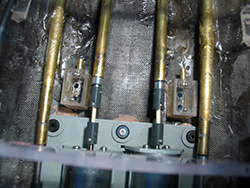 |
View of seachests installed into the bottom of the hull. The boxes were first attached using bondo between the
bottom edges and the hull, then a piece of fiberglass was attached to the inside walls and the hull to form a watertight, nearly-unbreakable seal.
The screws holding the cover plates are visible: the gaskets are not installed for this photo. The plastic shaft couplers installed on the inboard shafts
are placeholders I 3D-printed while waiting for brass pieces to be fabricated. |
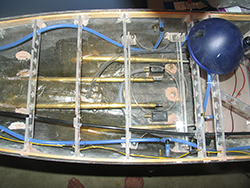 |
View of completed seachests. |
| |
|
|
|
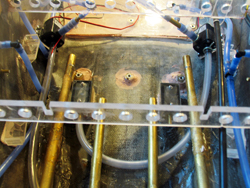 |
This view shows the two pumps installed on the sides of the hull and above the seachests. Inlet plumbing is
installed on the starboard pump (to the port seachest). |
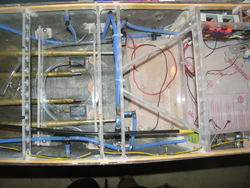 |
Overhead of pumps (beneath lateral frame, seachests (between each pair of propeller shafts), and plumbing. |
| |
|
|
|
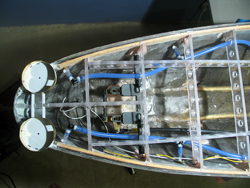 |
Plumbing arrangement for aft discharges. |
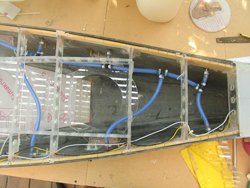 |
Plumbing arrangement for bow discharges. Similar lines are installed for the midships overboards. |
| |
|
|
|
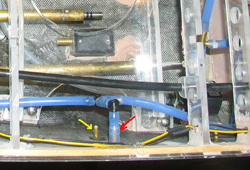 |
Closeup of one of the overboard discharge fittings. The red arrow points to the balancing plug installed at each
fitting. Just to the left of this fitting is one of the static discharges (yellow arrow). They are constructed in the same manner but have a plastic filler plug
bonded into the inner end and topped with epoxy. |
|
|
| |
|
|
|